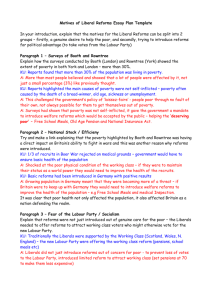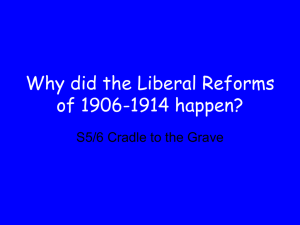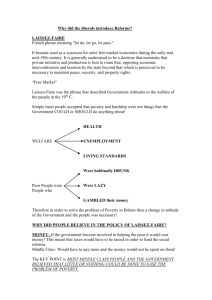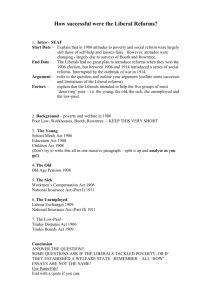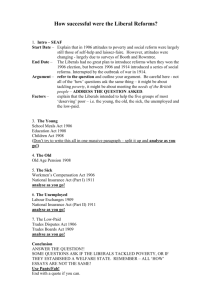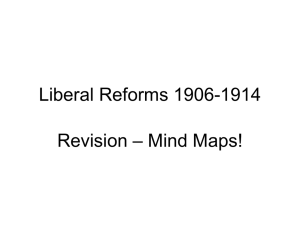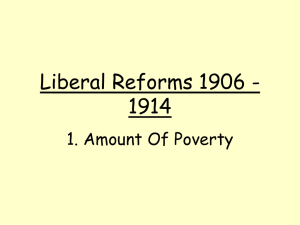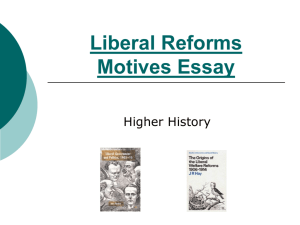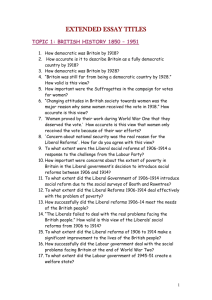LIBERAL MOTIVES - PP
advertisement
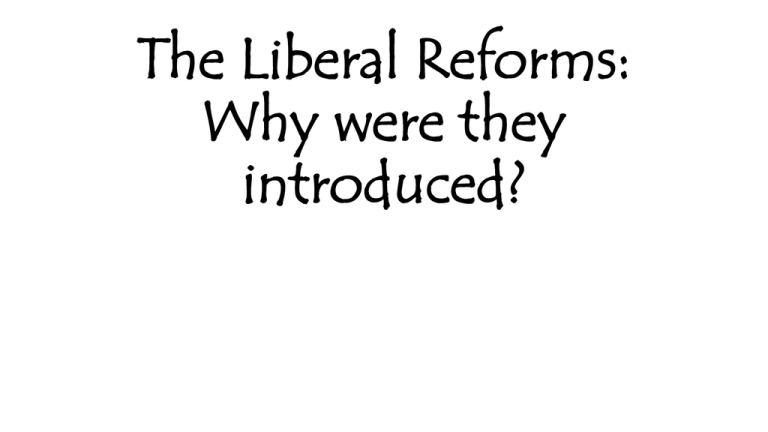
The Liberal Reforms: Why were they introduced? What were the Liberal Reforms? A series of welfare reforms which aimed to helped: • Children • Old People • Sick people • People who had low wages/were unemployed. Introduction: Contexts The liberal government came to power in 1906 with a landslide victory of 399 seats to the 156 of the Conservatives. During their election campaign they had focussed on their promise of free trade, yet, during their time in power, they introduced a series of welfare reforms aimed at helping those in need. The Liberal Party were in power from 1906 to 1914. During this time they introduced a series of welfare reforms which were designed to provide support for the 1/3 of Britain’s population who had been identified by Seebohm Rowntree and Charles Booth as living in poverty. When the Liberal Party came to power in 1906, the poverty line was at 21 shillngs per week and around one third of British families were below this – living in poverty. Through his study, Rowntree identified five main causes of poverty; old age, large families, unemployment/irregular work, low wages and the death/illness of main wage earner. Factors TASK: While watching the video, take a note of at least one FACT for each of the following: • National Efficiency • Social Awareness • Political Advantage By 1906 it was becoming difficult for the government to ignore the problem. Research findings of: Seebohm Rowntree Charles Booth The Social Surveys of Booth and Rowntree The large surveys into British poverty conducted by Booth and Rowntree provided the incoming Liberal Government with detailed evidence which had not been available to previous governments. Charles Booth’s “Survey of Life and Labour in London” completed in 1903, showed the huge level of poverty in London: nearly one third of the population. • 17 year study in London • 30% lived below poverty line • Only 3% received help from the Poor Law Seebohm Rowntree Poverty or bread line= basics (home, food, clothing) Seebohm Rowntree’s study of working class families in York: “Poverty: A study of Town Life” was published in 1901.It confirmed Charles Booth’s findings that one third of Britain’s population was living in poverty. • York • 30% lived below poverty line. • A family needed £1 a week to stay above the poverty line. Low wages 52% Death of main wage earner 16% Illness or old age 5% Unemployment or irregular work 5% Large families 22% Other evidence of poverty Socialists Social Democratic Federation tried to make people aware of conditions of poor. Writers Reverand A. Mearns ‘The Bitter Cry of Outcast London’ William Booth ‘Darkest London’ Charles Dickens ‘Oliver Twist. Teachers & Civil Servants Teachers complained to school inspectors that children were too hungry to learn. Medical officers (for local councils) reported on poor state of people’s health. Analysis • Due to increased public awareness of poverty it would seem – perhaps - that any party in power would have been under pressure to implement reforms for political survival. However, can be argued that social reforms were introduced as a result of these revelations: 1906 Free School Meals 1909 Housing Act (Although only outlined plans; no action actually taken) 1906 – Liberal Prime Minister, Henry Campbell-Bannerman believed in Gladstonian Laissez-Faire. However, a growing number Liberals saw the need for change. They had sympathy for the poor but were also worried by the rise in support for the Labour Party. They convinced their leaders to do more to help Britain’s poorest. Winston Churchill David Lloyd George Make Poverty History “Don’t be afraid to take a big step” Analysis • Evidence shows the move away from Laissez-faire after the death of Campbell Bannerman and the cabinet reshuffle – 1909 Peoples’ Budget caused a constitutional crisis. This cemented the idea that the better off should be taxed to help the poor. • Number of welfare reforms increased after DLG and Churchill brought into party – showing their influence important. • DLG responsible for OAPs and Churchill instrumental in National Insurance. Both wanted to help the poor but equally recognised political benefits i.e. more votes. Thus suggesting that power was also important. Analysis • The number of non-contributory benefits such as 1908 OAPs evidence the change in political philosophy and the extent to which they were influenced by revelations and new liberalism. • Other reforms also show that the new liberals had influenced a change in liberal ideology. E.g. 1908 Children’s Charter and 1909 Trades Board Act. 1. Threat from the Labour Party Labour MPs 1900 2 MPs 1906 29 MPs 1910 42 MPs Labour threatened the Liberals because in 1890, working class men were given the vote and the majority associated with Labour – the working man’s party. ‘The relief of poverty is always an act of power’ P. Hennock Speech by Lloyd George to a Liberal Party meeting in Cardiff, October 1906 I warn you about the Labour Party. I warn you it will become a terrifying force that will sweep away Liberalism. We have a Liberal Parliament, but we must act to help the poor. We must get rid of the national disgrace of slums. We must eliminate the widespread poverty which scars this land glittering with wealth, otherwise the working men of Britain will vote Labour instead of Liberal. Analysis • Labour was gaining support quickly. 1905 – 2 seats and increased to 29 in 1910. Liberals required a way to regain support from those voters. • This is evidenced by the Lib’s introduction of the Free School Meals Act which was originally suggested in parliament by a Labour MP. • Thus showing that the Lib’s were concerned that Labour had greater appeal to the working class. Analysis • The Liberal majority in 1910 was only TWO seats. • In 1907 they lost ‘safe’ seats e.g. Jarrow to Labour. • Historians argue that this led the Liberals to introduce pensions the following year. • Indeed, DLG said they would only be put out of power if they failed to deal with the problems of the people. • On the other hand, Labour was not the only threat. Some suggest the Liberals were also threatened by the Conservatives. 2. Threat from the Conservative Party The historian Morrison argues that the Conservatives posed a bigger threat to the Liberals than Labour. Housing Act 1890 The Conservatives had already introduced reforms… Education Act 1891 Workmen’s compensation Act 1897/ 1900 However it is worth noting that…… If the Liberals were concerned with maintaining power, why did they push through with the People’s Budget (tax increases to pay for OAP) in 1909? The Liberals called a General Election in 1910they won by only by 2 seats!!!!! Analysis • The 1909 Peoples’ Budget taxed the rich in order to introduce further reforms. Surely then, if the Liberals were more concerned about threat from Conservatives they would have tried to attract support from the wealthy. • Further to that, the Liberals may also have been losing support from workers. • Many actually objected to paying out the money for National Insurance. They got paid very little so any deduction (regardless of size) had detrimental consequences. • SUGGESTS: Liberals were in fact genuinely attempting to help those in need. 1. German Rivalry: German model of Social Welfare - Under Bismark, Germany had already introduced Social Reforms such as OAPs. Bismark had wanted to gain support of working class. - Germany’s welfare system was first in Europe. - Politicians including DLG visited Germany & were impressed by what they saw. Analysis • Evidence supports the argument that this was an important reason because: • The government introduced OAPs (1908) soon after Lloyd George returned from Germany. • Also Labour Exchanges 1909 were based on the German model. 2. British industry threatened - USA, Japan and Germany increasing economic competitionUSA could make steel cheaper than Britain. - British companies worried- e.g. Cadbury - 1905 Dundee Survey- children underweight (Children would be the workers & soldiers of the future) - Lord Rosebery believed in order to achieve this the Liberals would require a “healthier and better educated workforce” . Analysis • Concern over national efficiency evident as British industry already in decline due to poor health of workers. • To successfully compete with other nations, UK needed a strong & effective workforce. • Evidenced by introduction of Nat Insurance (Part 1) which covered 17 trades e.g. mining in times of sickness. Motivated by nat. efficiency because it gave support to workers so they could return to work fit and capable of working to their best. 3 – Empire (highlighted by the Boer War) • Took 3 years for 400,000 British soldiers to defeat 35,000 Boer farmers. • 34.6% of volunteers rejected due to ill health. 8000 rejected and only 1200 accepted in Manchester. • Concern that UK not able to defend its empire. Analysis • This shows national efficiency was an important motive because: • The government took steps to improve the efficiency of the army e.g. they introduced the Territorial Reserves & Expeditionary Force which was designed to back up the regular army. • The government also targeted the young with School Meals Act and Medical Inspections – to improve health of future soldiers. • Thus showing that national efficiency was an important motivation.

